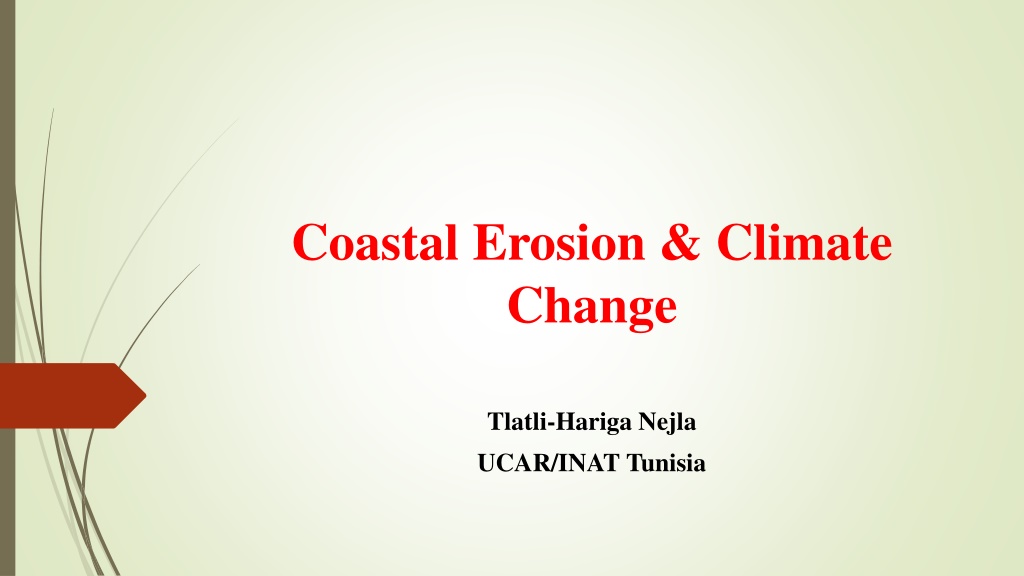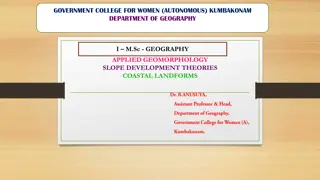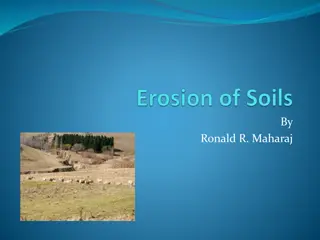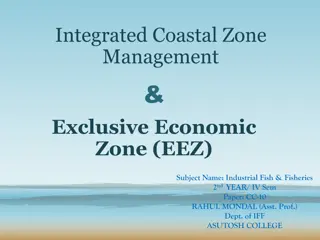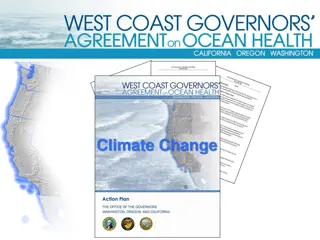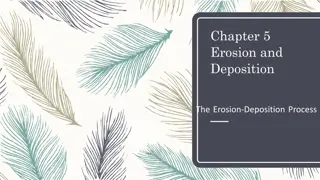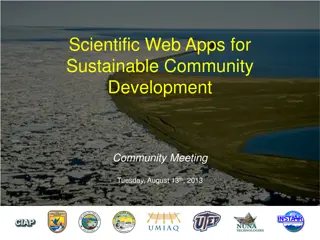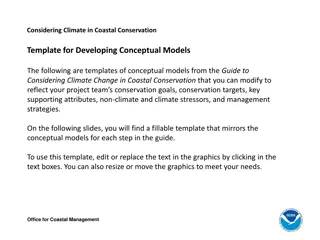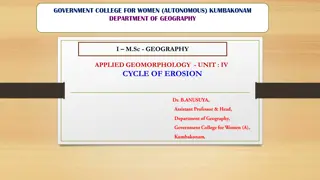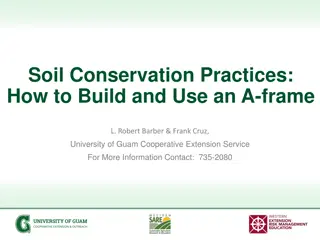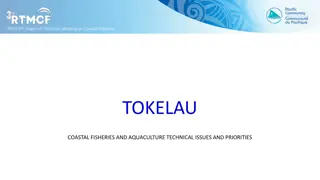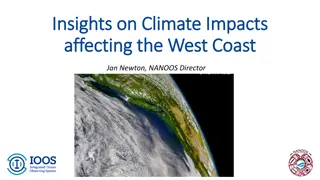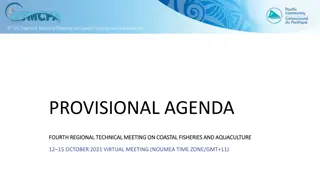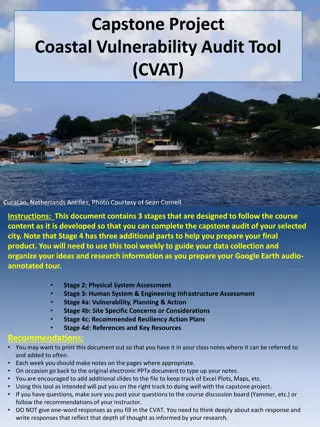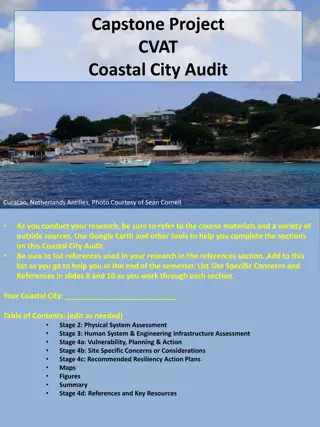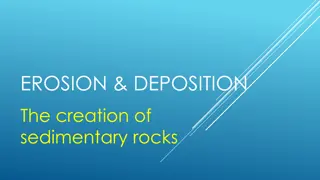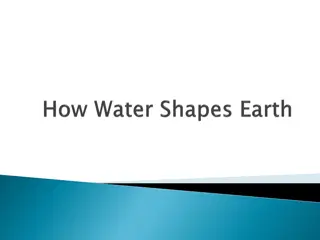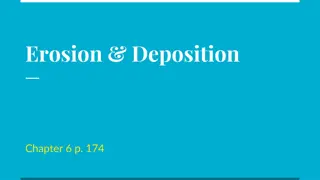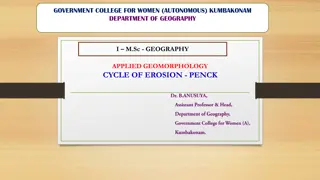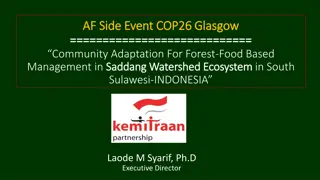Understanding Coastal Erosion and Climate Change Impact in Tunisia
Coastal erosion and climate change pose significant threats to Tunisia's coastal areas, affecting ecosystems, economy, and human livelihoods. Climate change exacerbates erosion through rising sea levels, extreme weather events, and human activities. Understanding these phenomena is crucial for sustainable coastal management and adaptation strategies.
Download Presentation

Please find below an Image/Link to download the presentation.
The content on the website is provided AS IS for your information and personal use only. It may not be sold, licensed, or shared on other websites without obtaining consent from the author. Download presentation by click this link. If you encounter any issues during the download, it is possible that the publisher has removed the file from their server.
E N D
Presentation Transcript
Coastal Erosion & Climate Change Tlatli-Hariga Nejla UCAR/INAT Tunisia
Definition of Climate Change 2 NASA s definition of climate change is: a broad range of global phenomena created predominantly by burning fossil fuels, which add heat-trapping gases to Earth s atmosphere. These phenomena include the increased temperature trends, but also changes such as sea-level rise; ice mass loss in Greenland, Antarctica, , shifts in flower/plant blooming; and extreme weather events.
3 Climate change is the global phenomenon of climate transformation characterized by the changes in the usual climate of the planet (specially temperature, precipitation, and wind) Principal causes of these changes are the human activities As a consequence of these changes, the sustainability of the planet s ecosystems is under threat, as well as the future of humankind and the stability of the global economy
Climate Change vs. Global Warming 4 According to the US Geological Survey, global warming is just one aspect of climate change. In fact, global warming refers only to the Earth s rising surface temperature, while climate change includes warming and the sideeffects of warming-like melting glaciers, heavier rainstorms, or more frequent drought. Ultimately, this means that global warming is one side of the much larger problem of human-caused climate change.
5 https://reliefweb.int/sites/reliefweb.int/files/resources/Tunisia_CRP.pdf
Definition of Coastal Erosion 6 Coastal erosion (or shoreline retreat) is the loss of coastal lands due to the net removal of sediments or bedrock from the shoreline. Coastal erosion can be either a: rapid-onset hazard: occurs very quickly, a period of days to weeks slow-onset hazard: occurs over many years, or decades to centuries
Causes of Coastal Erosion 7 The causes of erosion are both natural and anthropogenic (man-made). The natural causes are mainly: Rising sea levels due to climate change, melting ice at the poles and the greenhouse effect. Wind erosion which causes the disappearance of the coastal sediment stock following the onslaught of the wind. Exceptional storms and swells assault which cause sediment to disappear
8 The anthropogenic disturbances cause the cutting off of the natural supply of sediment to the beaches For example, the construction of coastal structures (such as breakwaters, harbors and seawalls) can lead to changes in coastal sediment and can also strongly influence the propensity of landforms to erode The construction of dams leads to the cutting off of a major source of sediment supply to the beaches
9 The removal of sediments from the coastal system (by dredging or sand mining, ), or a reduction in the supply of sediments (by the regulation of rivers) At larger scales, natural and human-induced climate change can modulate the likelihood and rate of coastal erosion.
12 Photographs of the previous slide shows the severe shoreline erosion trend of the Gulf of Hammamet (Tunisia) We can clearly observe the decrease in the width of the beaches and the growth of the urban areas (light disappearance of agriculture fields (dark areas) The arrows refer to the coastal urban structure built in the mid-50s and used herein as references in the threes images to visualize the shoreline retreat. areas) against the
13 in this photo, we can see that the shore has retreated by almost half a kilometer since 1887
How to quantify the coastline response to sea-level rise? The most widely cited method of quantifying the response of a shore to rising sea-levels is known as the Bruun rule. 14 This was developed to describe the behavior of sandy coasts with no cliff or shore platform. It assumes that average equilibrium beach profile does not change, but does translate up with the sea-level.
15 This rise in beach surface requires sand, which is assumed to be eroded from the upper beach and deposited on the lower beach. Thus, as the profile rises with sea level it also translates landward causing shoreline retreat. Note that despite the erosion of the upper beach no sand is actually lost; it simply translates a small distance down the profile
Bruun Rule Formula The mathematical formula of the Bruun Rule is: R = S *L /(h + B) = S/tan Where: o R : shoreline recession [m] o S : sea level rise [m] o L : the horizontal length of the bottom affected by the sea level rise (from the dune peak to depth of closure) [m] o h : the depth of closure (the water depth beyond which significant sediment transport does not occur) [m] o B : the dune height above sea level [m] o : the average slope of the active profile 16
18 The Bruun rule has been the subject of some debate and criticism, but is still generally supported although this rule does not represent long-shore transport, and restricted their study to sites where this could be neglected
19 Another constraint on the range of applicability of the Bruun rule results from its assumptions that the shore profile is entirely beach and loses no sediment. If the shore profile is composed of both beach and rock, the rock element of such composite shores complicates its behavior because it can only erode (not accrete) and it is likely to contain material that is lost as fine sediment. In addition, being purely erosive and relatively hard, it will have a different equilibrium profile to that of the beach and will take longer to achieve it
